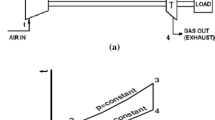Abstract
Cooling capacity decreases due to faults appearing over time in the thrust bearing oil cooling systems of hydroelectric power plants and cooling process cannot proceed sufficiently. For this reason, while the turbine-generator unit generates energy, the thrust bearing heats up. This temperature problem prevents the unit from operating at full capacity and therefore decreases in energy production. Producing deficient energy in hydroelectric power plants, which is a renewable energy source, causes long-term economic losses for countries. In this study, the thrust bearing cooling system of a vertical Francis turbine, which produces 150 MW of energy per hour, is investigated. The reduction in the cooling capacity over time in turbine thrust bearing cooling system is solved by using exchanger system with additional plate and the power produced by the turbine-generator unit is increased 15 MW/h. This improvement has greatly contributed to the national economy. The method of increasing the cooling capacity applied to the hydroelectric power plant thrust bearings can be applied to all hydraulic turbines. This method will increase the energy production amount of the unit by approximately 10% and it costs approximately 80% cheaper than completely replacing the existing cooling system.





Similar content being viewed by others
References
C. Kahraman, I. Kaya, A fuzzy multicriteria methodology for selection among energy alternatives. Expert Syst. Appl. 37, 6270–6281 (2010). https://doi.org/10.1016/j.eswa.2010.02.095
A. Lejeune, S.L. Hui, Hydropower: a multi benefit solution for renewable energy. Compr. Renew. Energy 6, 15–47 (2012). https://doi.org/10.1016/B978-0-08-087872-0.00602-8
O. Yuksek, M.I. Komurcu, I. Yuksel, K. Kaygusuz, The role of hydropower in meeting Turkey’s electric energy demand. Energy Policy 34(17), 3093–3103 (2006). https://doi.org/10.1016/j.enpol.2005.06.005
M. Opan, M. Ünlü, C. Özkale, C. Çelik, Hİ. Saraç, Optimal energy production from wind and hydroelectric power plants. Energy Sour. Part A: Recovery, Util. Environ. Eff. 41, 2–9 (2019)
X. Luo, A. Yu, B. Ji, Y. Wu, Y. Tsujimoto, Unsteady vortical flow simulation in a Francis turbine with special emphasis on vortex rope behavior and pressure fluctuation alleviation. Proc. Inst. Mech. Eng., Part A: J. Power Energy 231(3), 215–226 (2017). https://doi.org/10.1177/0957650917692153
C.P. Barros, Efficiency analysis of hydroelectric generating plants: a case study for Portugal. Energy Econ. 30, 59–75 (2008). https://doi.org/10.1016/j.eneco.2006.10.008
G. Kahraman, Y. Taşgin, Application of local hard fillet weld to repair damage caused by cavitation in hydroelectric power plant. J. Fail. Anal. Prev. (2020). https://doi.org/10.1007/s11668-020-00892-z
D. Momcilvic, Z. Odanovic, R. Mitrovic, I. Atanasovska, T. Vuherer, Failure analysis of hydraulic turbine shaft. Eng. Fail. Anal. 20, 54–66 (2012). https://doi.org/10.1016/j.engfailanal.2011.10.006
T.F. Peixoto, K.L. Cavalca, Investigation on the angular displacements influence and nonlinear effects on thrust bearing dynamics. Tribol. Int. 131, 554–566 (2019). https://doi.org/10.1016/j.triboint.2018.11.019
W. Wang, P.E. Allaire, Theoretical and experimental study on the static and dynamic characteristics of tilting-pad thrust bearing. Tribol. Int. 123, 26–36 (2018). https://doi.org/10.1016/j.triboint.2018.02.019
D. Gropper, L. Wang, Numerical analysis and optimization of surface textures for a tilting pad thrust bearing. Tribol. Int. 124, 134–144 (2018). https://doi.org/10.1016/j.triboint.2018.03.034
M.P. Porto, L.C. Porto, R.N. Koury, E.W. Soares, G. Coelho, L. Machado, A case study on thrust bearing failures at the SÃO SIMÃO hydroelectric power plant. Case Stud. Thermal Eng. 1, 1–6 (2013). https://doi.org/10.1016/jcsite.2013.07.001
S.D. Pandey, V.K. Nema, An experimental investigation of exergy loss reduction in corrugated plate heatexchanger. Energy 36, 2997–3001 (2011). https://doi.org/10.1016/j.energy.2011.02.043
Y. Zhang, C. Jiang, B. Shou, W.X. Zhou, Z. Zhang, S. Wang, B. Bai, A quantitative energy efficiency evaluation and grading of plate heatexchangers. Energy 142, 228–233 (2018). https://doi.org/10.1016/j.energy.2017.10.023
F. Sun, X. Chen, L. Fu, S. Zhang, Configuration optimization of an enhanced ejector heat exchangerbased on an ejector refrigerator and a plate heat exchanger. Energy 164, 408–417 (2018). https://doi.org/10.1016/j.energy.2018.08.194
V. Kumar, A.K. Tiwari, S.K. Ghosh, Effect of variable spacing on performance of plate heat exchangerusing nanofluids. Energy 114, 1107–1119 (2016). https://doi.org/10.1016/j.energy.2016.08.091
H. Mergner, K. Schaber, Performance analysis of an evaporation process of plate heat exchangers installed in a Kalina power plant. Energy 145, 105–115 (2018). https://doi.org/10.1016/j.energy.2017.12.105
Z.D. Fan, J.S. Du, Z.B. Zhang, Y.C. Ma, S.Y. Cao, K. Niu, C.X. Liu, Internal leakage of plate heat exchangers caused by cooperation of pitting, crevice corrosion, and fretting. Eng. Fail. Anal. 96, 340–347 (2019). https://doi.org/10.1016/j.engfailanal.2018.10.007
A. Gagliardi, A. Lanzutti, M. Simonato, R. Furlanetto, M. Magnan, F. Andreatta, L. Fedrizzi, Failure analysis of a plate heat exchanger used in a blast chiller. Eng. Fail. Anal. 92, 289–300 (2018). https://doi.org/10.1016/j.engfailanal.2018.06.005
M. Mihailovic, U. Milovancevic, S. Genic, B. Jacimovic, M. Otovic, P. Kolendic, Air side heat transfer coefficient in plate finned tube heat exchangers. Exp. Heat Transf. 17, 886–893 (2010). https://doi.org/10.1016/j.engfailanal.2009.10.023
Author information
Authors and Affiliations
Corresponding author
Additional information
Publisher's Note
Springer Nature remains neutral with regard to jurisdictional claims in published maps and institutional affiliations.
Rights and permissions
About this article
Cite this article
Kahraman, G. Increasing the Power Generation by Raising the Capacity of the Thrust Bearing Oil Cooling System in Hydroelectric Power Plants. J Fail. Anal. and Preven. 20, 1445–1449 (2020). https://doi.org/10.1007/s11668-020-00969-9
Received:
Accepted:
Published:
Issue Date:
DOI: https://doi.org/10.1007/s11668-020-00969-9



